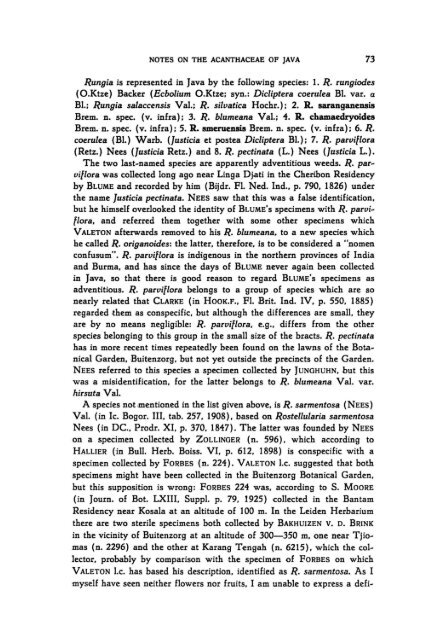Notes on the acanthaceae of Java - DWC
Notes on the acanthaceae of Java - DWC
Notes on the acanthaceae of Java - DWC
You also want an ePaper? Increase the reach of your titles
YUMPU automatically turns print PDFs into web optimized ePapers that Google loves.
NOTES ON THE ACANTHACEAE OF JAVA 73<br />
Rungia is represented in <strong>Java</strong> by <strong>the</strong> following species: 1. R. rungiodes<br />
(O.Ktze) Backer (Ecbolium O.Ktze; syn.: Dicliptera coerulea BI. var. a<br />
BI.; Rungia salaccensis Val.; R. silvatica Hochr. ); 2. R. saranganensis<br />
Brem. n. spec. (v. infra); 3. R. blumeana Val.; 4. R. chamaedryoides<br />
Brem. n. spec. (v. infra); 5. R. smeruensis Brem. n. spec. (v. infra); 6. R.<br />
coerulea (BI.) Warb. (Justicia et postea Dicliptera Bl.); 7. R. parviflora<br />
(Retz.) Nees (Justicia Retz.) and 8. R. pectinata (L.) Nees (Justicia L.).<br />
The two last-named species are apparently adventitious weeds. R. parviflora<br />
was collected l<strong>on</strong>g ago near Linga Djati in <strong>the</strong> Cherib<strong>on</strong> Residency<br />
by BLUME and recorded by him (Bijdr. FI. Ned. Ind .• p. 790. 1826) under<br />
<strong>the</strong> n'ame ]usticia pectinata. NEEs saw that this was 'a false identificati<strong>on</strong>.<br />
but he himself overlooked <strong>the</strong> identity <strong>of</strong> BLuME's specimens with R. parviflora.<br />
and referred <strong>the</strong>m toge<strong>the</strong>r with some o<strong>the</strong>r specimens which<br />
VALET{)N afterwaros removed to his R. blumeana. to a new species which<br />
he called R. origanoides: <strong>the</strong> latter. <strong>the</strong>refore. is to be c<strong>on</strong>sidered a "nomen<br />
c<strong>on</strong>fusum". R. parviflora is indigenous in <strong>the</strong> nor<strong>the</strong>rn provinces <strong>of</strong> India<br />
and Burma. and has since <strong>the</strong> days <strong>of</strong> BLuME never again been collected<br />
in <strong>Java</strong>. so that th ere is good reas<strong>on</strong> to regard BLUME's specimens as<br />
adventitious. R. parviflora bel<strong>on</strong>gs to a group <strong>of</strong> species which are sa<br />
nearly related that CLARKE (in HOOK.F .• FI. Brit. Ind. IV. p. 550. 1885)<br />
regarded ,<strong>the</strong>m as c<strong>on</strong>specific. but although <strong>the</strong> differences are smalt <strong>the</strong>y<br />
are by na means negligible: R. parviflora. e.g .• differs from <strong>the</strong> o<strong>the</strong>r<br />
species bel<strong>on</strong>ging to thisgroup in <strong>the</strong> small size <strong>of</strong> <strong>the</strong> bracts. R. pectinata<br />
has in more recent times repeatedly been found <strong>on</strong> <strong>the</strong> lawns <strong>of</strong> <strong>the</strong> Botanical<br />
Garden. Buitenzorg. but not yet outside <strong>the</strong> precincts <strong>of</strong> <strong>the</strong> Garden.<br />
NEES referred to this species a specimen collected by JUNGHUHN. but this<br />
was a misidentificati<strong>on</strong>. for <strong>the</strong> latter bel<strong>on</strong>gs to R. blumeana Val. var.<br />
hirsuta Val.<br />
A species notmenti<strong>on</strong>ed in <strong>the</strong> list given above. is R. sarmentosa (NEEs)<br />
Val. (in Ic. Bogor. III. tab. 257. 1908). based <strong>on</strong> Rostellularia sarmentosa<br />
Nees (in DC .• Prodr. XI. p. 370. 1847). The latter was founded by NEEs<br />
<strong>on</strong> a specimen collected by ZOLLINGER (n. 596). which according to<br />
HALLJER (in Bull. Herb. Boiss. VI. p. 612. 1898) is c<strong>on</strong>specific with a<br />
specimen collected by FORBES (n. 224). VALETON l.c. suggested that both<br />
specimens might have been collected in <strong>the</strong> Buitenzorg Botanical Garden.<br />
but this suppositi<strong>on</strong> is wr<strong>on</strong>g: FORBEs 224 was. according to S. MOORE<br />
(in Journ. <strong>of</strong> Bot. LXIII. Suppl. p. 79. 1925) collected in <strong>the</strong> Bantam<br />
Residency near Kosala at an altitude <strong>of</strong> 100 m. In <strong>the</strong> Leiden Herbarium<br />
<strong>the</strong>re are two sterile specimens both collected by BAKHUIZEN V. D. BRINK<br />
in <strong>the</strong> vicinity <strong>of</strong> Buitenzorg at an altitude <strong>of</strong> 300-350 m. <strong>on</strong>e near Tjiomas<br />
(n. 2296) and <strong>the</strong> o<strong>the</strong>r at Karang Teng'ah (n. 6215). which <strong>the</strong> collector.<br />
probably by comparis<strong>on</strong> with <strong>the</strong> specimen <strong>of</strong> FORBES <strong>on</strong> which<br />
VALETON l.c. has based his descripti<strong>on</strong>. identified as R. sarmentosa. As I<br />
myself have seen nei<strong>the</strong>r flowers nor fruits. 1 am unable to express a defi-

















